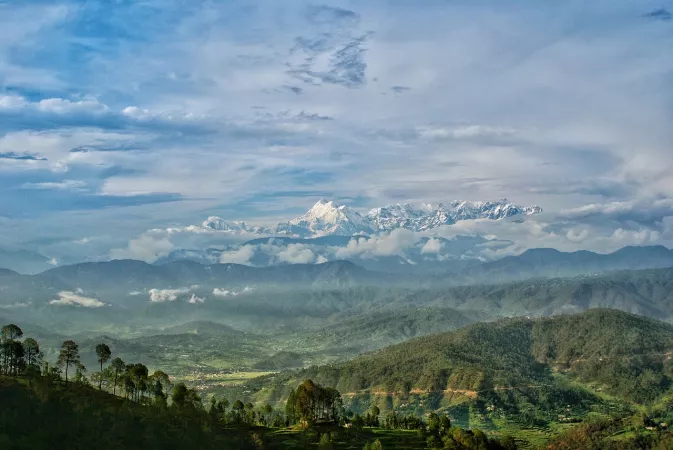Hi User
Navigation

Dwarahat
Ranikhet . Uttarakhand . India
Duration
2 to 4 Days
2 to 4 Days
Best time to visit
Mar-Jun, Sep-Nov
Mar-Jun, Sep-Nov
Theme
Hill Station, Religious, Heritage
Hill Station, Religious, Heritage
Dwarahat Travel Guide
Dwarahat, located in the Almora district of Uttarakhand, India, is a hidden gem known for its historical significance and stunning natural beauty. This ancient town was once a prominent seat of power during the medieval period and is dotted with numerous temples and historical sites. The town is nestled amidst the Kumaon hills, offering breathtaking views of the surrounding mountains and valleys. Dwarahat is famous for its rich cultural heritage, ancient temples, and serene atmosphere, making it a perfect destination for history buffs and nature lovers alike.Top Attractions in Dwarahat
- Doonagiri Temple
- Dunagiri Trek
- Pandukholi Caves
- Baijnath Temple
- Kacheri Village
Dwarahat is Famous for
Its ancient temples and historical significance.Top Attractions in Dwarahat
- Doonagiri Temple
- Dunagiri Trek
- Pandukholi Caves
- Baijnath Temple
- Kacheri Village
What's Great about Travelling to Dwarahat?
- Rich cultural heritage
- Scenic beauty
- Peaceful atmosphere
- Opportunities for trekking
What's Not So Great about Travelling to Dwarahat?
- Limited accommodation options
- Lack of commercialization
- Remote location
- Limited dining options
Travel Tips for Dwarahat
- Carry sufficient cash as ATMs may be limited
- Respect local customs and traditions
- Wear comfortable walking shoes
- Check weather conditions before trekking
Important Dwarahat trip information
- Ideal Duration: 2-3 days
- Best Time to Visit: March to June and September to November
- Nearby Airports and Railway Stations: Pantnagar Airport and Kathgodam Railway Station
FAQ's on Dwarahat
Q1: What is the best time to visit Dwarahat?
The best time to visit Dwarahat is during the summer months from March to June when the weather is pleasant and ideal for exploring the outdoors. Monsoon season from July to September brings heavy rainfall, which may hinder travel plans. Winter, from October to February, is cold but offers a unique charm with clear skies and the possibility of snowfall, making it suitable for those who enjoy the cold weather.
Q2: Do I need a visa to travel to Dwarahat?
Tourists visiting Dwarahat typically do not require a visa if they hold an Indian passport. However, international travelers should check with the Indian embassy or consulate in their country to confirm visa requirements based on their nationality. It is advisable to have a valid passport and necessary travel documents when visiting Dwarahat.
Q3: What are the must-visit attractions in Dwarahat?
Dwarahat is known for its historical and cultural attractions. Some must-visit places include the ancient temples like Dunagiri Temple, Doonagiri Temple, and the Dwarahat Temple Complex. Nature lovers can explore the beautiful Pandukholi Caves and the scenic views from the Syahi Devi Temple. Additionally, the Kukuchina Tal and the nearby Baijnath Temple are popular pilgrimage sites worth visiting for their spiritual significance.
Q4: Is Dwarahat a safe place to travel?
Dwarahat is generally a safe destination for travelers. However, like any other place, it is essential to take standard safety precautions such as avoiding isolated areas at night and keeping an eye on personal belongings. It is recommended to stay informed about local news and follow any travel advisories issued by the authorities. Overall, exercising common sense and being cautious will contribute to a safe and enjoyable trip to Dwarahat.
Q5: What is the local currency in Dwarahat and can I use credit cards?
The local currency in Dwarahat is the Indian Rupee (INR). While credit cards are accepted in some hotels, restaurants, and larger establishments, it is advisable to carry cash for smaller transactions and in more rural areas. ATMs are available in major towns, but it is recommended to carry sufficient cash when traveling to remote locations or villages. Currency exchange services may be limited, so it's best to plan ahead for financial needs.
Q6: What is the local cuisine like in Dwarahat?
The local cuisine of Dwarahat offers a mix of traditional Kumaoni dishes and North Indian flavors. Must-try dishes include Bhatt ki Churkani (black bean curry), Aloo Ke Gutke (spiced potatoes), and Bal Mithai (a sweet delicacy). Food in Dwarahat is often prepared using local ingredients and traditional methods, showcasing the region's culinary heritage. Travelers with dietary restrictions can find options like vegetarian meals, rice dishes, and fresh fruits available in many eateries across Dwarahat.
Q7: What transportation options are available in Dwarahat?
Transportation in Dwarahat primarily consists of local buses, taxis, and auto-rickshaws for getting around the town and nearby areas. Hiring a private car or taxi is a convenient way to explore the region at your own pace. Public buses connect Dwarahat to major cities and towns in the region, offering an affordable mode of transport for budget travelers. Additionally, renting a motorcycle or bicycle can be a fun way to navigate the scenic roads and countryside surrounding Dwarahat.
Q8: Are there any cultural norms or etiquette I should be aware of when visiting Dwarahat?
When visiting Dwarahat, it is important to respect the local customs and traditions of the Kumaoni culture. Dress modestly, especially when visiting religious sites and interacting with locals. Removing footwear before entering temples or homes is a common practice. Greeting people with a 'Namaste' is appreciated, and showing courtesy towards elders is considered a sign of respect. Avoid public displays of affection and be mindful of photography restrictions in certain places. Learning a few basic phrases in the local language can also enhance your cultural experience and show your appreciation for the community.
Q9: I am a travel agent. How can I buy travel leads of Dwarahat?
Register yourself as a travel agent at agents.tripclap.com and then you can buy travel leads to Dwarahat once your account is approved. For more details contact our support team at +91-8069186564 or support@tripclap.com
Certified
We accept (more)
Members of
Media Recognition
Trusted Partners
Award
Copyrights © TripClap. All Rights Reserved
